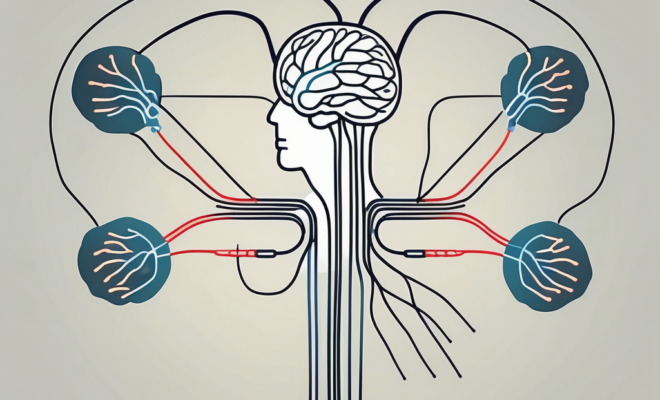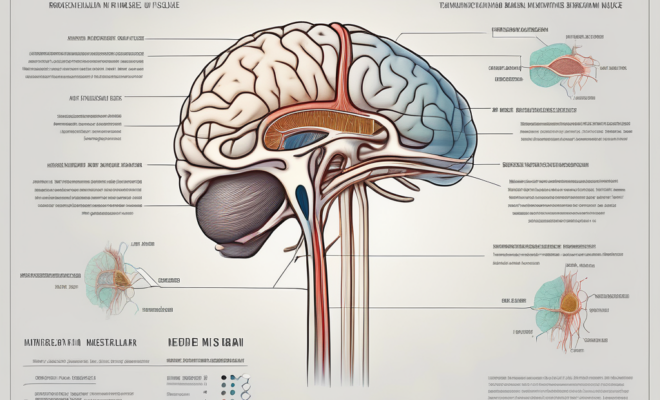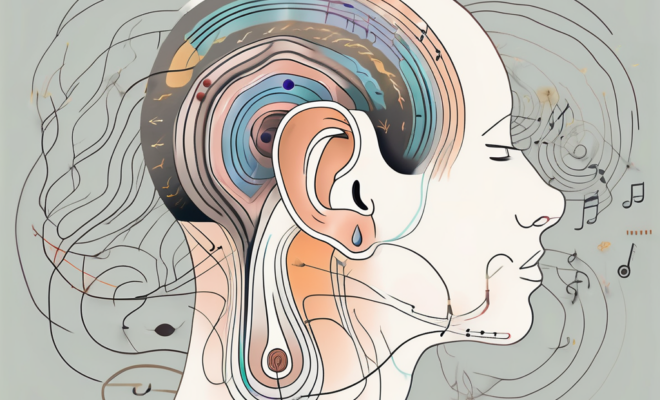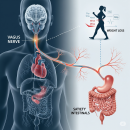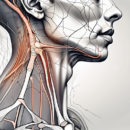The Role of the Accessory Nerve in Human Anatomy
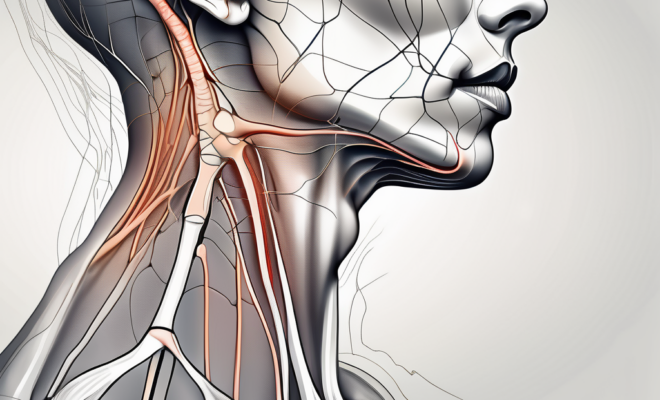
The accessory nerve, also known as the cranial nerve XI, is a crucial component of the human anatomy. It plays a significant role in various functions, including neck and shoulder movements, voice production, and overall motor control. Understanding the importance of the accessory nerve is essential for medical professionals, researchers, and individuals seeking insight into the complexities of the human body.
Understanding the Accessory Nerve
Before delving into the functions and disorders associated with the accessory nerve, it is essential to comprehend its definition and basic structure. The accessory nerve is a motor nerve, originating from the medulla oblongata in the brainstem. It consists of two main components: the cranial portion, which arises from the nucleus ambiguus, and the spinal portion, which emerges from the anterior gray horns of the upper cervical spinal cord.
The cranial portion of the accessory nerve primarily innervates voluntary muscles involved in swallowing, such as the pharyngeal and laryngeal muscles. On the other hand, the spinal portion innervates the trapezius and sternocleidomastoid muscles, which are responsible for neck and shoulder movements.
Understanding the intricate pathways and connections of the accessory nerve sheds light on its crucial role in motor function and coordination. The accessory nerve, also known as cranial nerve XI, plays a significant role in facilitating movements essential for daily activities such as head turning, shoulder shrugging, and maintaining posture.
Location and Pathway of the Accessory Nerve
The accessory nerve follows a unique pathway from its origin to the muscles it innervates. It emerges from the skull via the jugular foramen, situated between the temporal and occipital bones. From there, it descends through the posterior triangle of the neck, giving branches to the trapezius muscle.
After supplying the trapezius muscle, the accessory nerve descends deeper into the neck, passing anteriorly to the levator scapulae muscle. It then meets the sternocleidomastoid muscle, branching into numerous motor fibers that provide essential innervation for this muscle.
The intricate pathway of the accessory nerve not only highlights its anatomical significance but also underscores its role in coordinating complex movements involving the neck and shoulders. This nerve’s ability to innervate multiple muscles with distinct functions showcases the precision and coordination required for everyday tasks like turning the head, lifting the shoulders, and maintaining proper posture.
Functions of the Accessory Nerve
The accessory nerve’s multifaceted functions highlight its significance in various aspects of human motion and expression. Here, we explore its role in neck and shoulder movements, as well as its involvement in voice production.
Role in Neck and Shoulder Movements
The spinal portion of the accessory nerve contributes to the coordinated movement of the neck and shoulders. It controls the trapezius and sternocleidomastoid muscles, both of which play crucial roles in these motions. The trapezius muscle, innervated by the accessory nerve, allows for scapular elevation, depression, retraction, and rotation. Conversely, the sternocleidomastoid muscle enables head rotation and lateral flexion.
Together, these muscles work in synchrony, facilitating smooth and controlled movements of the neck and shoulders. The trapezius, with its broad attachment points on the spine, skull, and clavicle, acts as a stabilizer for the shoulder girdle, ensuring proper alignment and support during various activities. The sternocleidomastoid, on the other hand, provides stability and mobility to the head, allowing for precise movements and positioning.
Damage or dysfunction of the accessory nerve can result in weakness or impaired function of these muscles, leading to limited range of motion and difficulties in daily activities. Individuals may experience pain, stiffness, and muscle imbalances, which can significantly impact their overall quality of life.
Accessory Nerve and Voice Production
In addition to its role in neck and shoulder movements, the accessory nerve has significant implications for voice production. The cranial portion of the nerve innervates the muscles involved in swallowing, which indirectly impact vocalization. Coordination between the accessory nerve and other cranial nerves, such as the vagus nerve, is essential for proper vocal function.
By effectively controlling the laryngeal and pharyngeal muscles, the accessory nerve contributes to the modulation of sound during speech, singing, and other vocal activities. The larynx, commonly known as the voice box, houses the vocal cords and is responsible for producing sound. The accessory nerve plays a crucial role in regulating the tension and position of the vocal cords, allowing for precise control over pitch, volume, and resonance.
Dysfunction of the accessory nerve can result in impaired vocal control and voice quality. Individuals may experience hoarseness, breathiness, or difficulty projecting their voice. Recognizing the connection between the accessory nerve and vocal function is vital for clinicians working with patients experiencing voice-related difficulties or disorders. Comprehensive assessment and targeted interventions can help individuals regain optimal vocal function and improve their overall communication abilities.
Disorders Associated with the Accessory Nerve
While the accessory nerve plays a critical role in human anatomy, it is not immune to disorders and injuries that can affect its function. Understanding the causes, symptoms, and diagnosis of accessory nerve disorders is crucial for appropriate management and treatment.
The accessory nerve, also known as cranial nerve XI, is a motor nerve that controls the movement of certain muscles in the neck and shoulders. It originates in the brainstem and travels down the spinal cord before branching out to innervate the trapezius and sternocleidomastoid muscles. These muscles are responsible for important movements, such as lifting the shoulders, rotating the head, and maintaining a stable posture.
Causes of Accessory Nerve Damage
Damage to the accessory nerve can arise from various factors, including trauma, surgical interventions, infections, and neurological conditions. Trauma, such as neck injuries or surgeries, can lead to direct injury or compression of the nerve, interfering with its normal function.
Infections, such as viral or bacterial meningitis, can also affect the accessory nerve. The inflammation caused by these infections can disrupt the nerve’s pathways and impair its ability to transmit signals properly. Additionally, neurological conditions like motor neuron diseases, tumors, or demyelinating disorders may impact the nerve’s structure or function.
It is important to note that the accessory nerve can be affected at different points along its course. For example, damage to the nerve at its origin in the brainstem can result in more widespread effects compared to damage at a peripheral location. An accurate diagnosis of the underlying cause is crucial in determining the appropriate treatment approach.
Symptoms and Diagnosis of Accessory Nerve Disorders
Depending on the underlying cause and the extent of nerve damage, the symptoms related to accessory nerve disorders can vary significantly. Common manifestations include weakness or paralysis of the trapezius and sternocleidomastoid muscles, resulting in decreased range of motion and muscle atrophy.
Patients may experience difficulty in lifting or rotating their shoulders, turning their heads, or maintaining a stable posture. These limitations can have a significant impact on daily activities and quality of life. In some cases, voice changes or swallowing difficulties may also be present, as the accessory nerve plays a role in controlling certain muscles involved in speech and swallowing.
A comprehensive evaluation, including a detailed medical history, physical examination, and specialized neuroimaging tests, is essential for an accurate diagnosis of accessory nerve disorders. The medical history may reveal important information about the onset and progression of symptoms, as well as any previous trauma or infections. During the physical examination, the healthcare provider will assess the strength and function of the affected muscles, as well as the range of motion in the neck and shoulders. Neuroimaging tests, such as magnetic resonance imaging (MRI), can help visualize the nerve and identify any structural abnormalities or lesions.
Early diagnosis and intervention are crucial in managing accessory nerve disorders. Treatment options may include physical therapy to improve muscle strength and range of motion, medications to manage pain or inflammation, and in some cases, surgical interventions to repair or bypass damaged portions of the nerve. The specific treatment plan will depend on the underlying cause and the individual patient’s needs and goals.
Treatment and Rehabilitation of Accessory Nerve Disorders
Management of accessory nerve disorders focuses on addressing the underlying cause, alleviating symptoms, and facilitating rehabilitation for optimal recovery. Depending on the severity and specific circumstances, treatment options may range from conservative measures to surgical interventions.
Surgical Interventions
In cases where trauma or structural abnormalities are present, surgical intervention may be necessary. The goal of surgery is to repair or reconstruct the damaged nerve, restoring its normal function and promoting recovery. Specialized surgical techniques, such as nerve grafting or neurolysis, may be employed to improve outcomes and enhance patient rehabilitation.
During nerve grafting, a healthy nerve is harvested from another part of the body and used to bridge the gap in the damaged accessory nerve. This allows for the regeneration of nerve fibers and promotes the restoration of motor function. Neurolysis, on the other hand, involves the removal of scar tissue or other obstructions that may be compressing the accessory nerve, thereby relieving symptoms and facilitating recovery.
Physical Therapy and Rehabilitation
Physical therapy plays a pivotal role in the rehabilitation of accessory nerve disorders. A tailored program is designed to address specific muscular weaknesses, restore range of motion, and improve functional abilities. Techniques may include therapeutic exercises, manual therapy, and neuromuscular reeducation.
Therapeutic exercises focus on strengthening the affected muscles and improving their coordination. This helps individuals regain control and mobility, allowing them to perform daily activities with greater ease. Manual therapy techniques, such as massage and joint mobilization, can help reduce pain and stiffness, while also promoting tissue healing.
Neuromuscular reeducation is another important aspect of physical therapy for accessory nerve disorders. This technique involves the use of specialized exercises and activities to retrain the brain and muscles to work together effectively. By improving the connection between the nervous system and muscles, individuals can regain optimal movement patterns and functional abilities.
Additionally, speech therapy may be beneficial for those experiencing voice-related difficulties. Speech-language pathologists work closely with patients to enhance vocal control, optimize articulation, and promote vocal hygiene practices. Rehabilitation aims to improve overall function and quality of life for individuals affected by accessory nerve disorders.
In conclusion, the treatment and rehabilitation of accessory nerve disorders involve a multifaceted approach. Surgical interventions may be necessary in cases of trauma or structural abnormalities, while physical therapy and speech therapy play crucial roles in promoting recovery and restoring function. By addressing the underlying cause and providing comprehensive rehabilitation, individuals with accessory nerve disorders can achieve optimal outcomes and improve their quality of life.
The Accessory Nerve in Medical Research
Beyond clinical applications, the accessory nerve remains an area of ongoing research and exploration. Recent discoveries and advances have shed light on its intricate connections and potential therapeutic implications.
One recent study conducted by a team of neuroscientists focused on the accessory nerve’s role in motor control and neuroplasticity. Through a series of experiments on animal models, they found that the accessory nerve plays a crucial role in fine motor skills, such as finger dexterity and hand-eye coordination. These findings have significant implications for patients with motor impairments, as researchers can now explore targeted therapies to enhance accessory nerve function and improve motor control.
Recent Discoveries and Advances
New studies have revealed further insights into the accessory nerve’s role in motor control and neuroplasticity. Researchers have explored the regenerative potential of the accessory nerve and its ability to reestablish functional connections in cases of nerve injury or damage.
Another recent breakthrough in accessory nerve research is the discovery of a specific protein that promotes nerve regeneration. Scientists have identified a growth factor called “neurotrophin-3” that plays a crucial role in stimulating accessory nerve regrowth. This finding opens up possibilities for targeted drug therapies that can enhance accessory nerve regeneration and improve patient outcomes.
There is growing interest in understanding the molecular mechanisms and signaling pathways involved in accessory nerve regeneration. This valuable knowledge may pave the way for innovative approaches, such as stem cell therapies or neurostimulation techniques, to enhance nerve regeneration and functional recovery.
Future Directions in Accessory Nerve Research
As technology and scientific understanding continue to advance, the future of accessory nerve research holds immense potential. Further exploration of the accessory nerve’s intricate connections with other cranial nerves, the central nervous system, and the musculoskeletal system may provide deeper insights into its broader functional roles.
Researchers are also investigating the role of the accessory nerve in chronic pain conditions. Preliminary studies suggest that the accessory nerve may contribute to the development and maintenance of certain types of chronic pain, such as migraines. Understanding the underlying mechanisms can lead to the development of novel therapeutic interventions targeting the accessory nerve, providing relief for millions of individuals suffering from chronic pain.
Innovative research methodologies, such as neuroimaging techniques and genetic profiling, have the potential to unravel new avenues for diagnosis, treatment, and prevention of accessory nerve disorders. Collaborative efforts across multidisciplinary fields are essential to drive progress and uncover the full extent of the accessory nerve’s significance in human anatomy.
Conclusion
The accessory nerve represents a crucial component of human anatomy, underscoring its vital functions in neck and shoulder movements, voice production, and motor control. A comprehensive understanding of the accessory nerve is invaluable for medical professionals, researchers, and those seeking knowledge about the intricacies of the human body.
While disorders of the accessory nerve may present challenges, ongoing research and advancements in diagnosis, treatment, and rehabilitation offer hope for improved outcomes and enhanced quality of life. With continued exploration and collaboration, we can further unlock the mysteries surrounding the accessory nerve and harness its potential for the benefit of countless individuals.




